Almost a Century After Its Construction, a Celebrated Long Beach, California, Hotel Enters Its Next Era
Every grand hotel has stories, but Fairmont Breakers in Long Beach, California, has more than most. Yes, John Wayne used to hang out at the bar and a young Elizabeth Taylor spent the very first of her eight wedding nights there and Charles Lindbergh is said to have once steered himself to safety through the fog by the brightly illuminated “B” on its rooftop. Yet the building also saw years when its stories revolved around the quiet lives of retirees living amid its fading elegance, or when it served as a Red Cross headquarters after a devastating earthquake, or when pillbox structures mounted with guns projected from its rooftop, and later when all its stories seemed to come to an end, its abandoned halls echoing only with silence.
Through it all, the hotel, christened the Breakers Hotel in 1926 when it opened next to the beach, remained an imposing presence in the life of Long Beach’s residents, a Spanish Renaissance Revival landmark with a history that traced the changing fortunes of its hometown.
Today the reborn Fairmont Breakers Long Beach, which reopened last November after a $160 million rehabilitation, continues to honor that history but stands equally as a measure of the city’s aspirations for its future. The five-star hotel, now part of the Fairmont Hotels & Resorts luxury chain, illustrates the challenges that come with preserving the essence of an iconic building’s past while fitting it to succeed in the present.
“In the areas that were still preserved to some extent, it was important for us to bring it back as historically accurate as it could be,” says Kasra Esteghamat of the design and travel company Eden For Your World. (Esteghamat served as the lead design and development representative for Pacific6, the locally based firm that bought the property in 2017.) But at the same time, he adds, the developers saw that “this hotel needed to take a modern view of its historic nature.” The team worked with multiple design firms over the years to make this happen, including RVD Associates, HBA, Nadel Architects, and GMA, as well as restoration specialist Spectra Company.
The rehabilitation effort received federal historic tax credits and a 2025 Preservation Award from the Los Angeles Conservancy. It entailed restoring the building’s cast stone and plaster exterior, as well as key spaces and architectural details. It also included the thoughtful use of memorabilia from different periods in the hotel’s history and a creative approach to recapturing the grandeur of the hotel’s era of highest style.
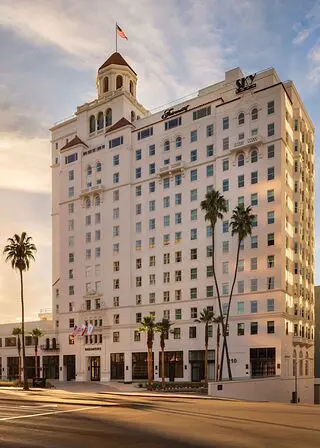
photo by: Fairmont Breakers Long Beach
Fairmont Breakers' street elevation today.
“This hotel needed to take a modern view of its historic nature.”
Kasra Esteghamat
Pacific6 specializes in environmentally or socially significant projects. The development and investment firm’s partners all hail from the Long Beach area. Although it has a population of nearly half a million and is a center of the region’s oil and shipping industries, Long Beach is an archetypal second city, sitting in the long shadow of Los Angeles. Civic pride tends to run deep in places like that, and John Molina, a founding member of Pacific6, admits returning the Breakers to its original use as a luxury hotel in the heart of the city was a passion project for the firm.
“I passed the building en route to work for three decades, and it was sad to see it being used for other things,” Molina says. “There were alterations that removed much of its historic character. When it was an assisted living center, unless you were a resident or visiting a resident, you couldn’t go into the lobby. We had a beautiful lobby with original wood paneling and a plaster ceiling, and nobody could see it.”
Those plaster details have been restored as touchstones to the hotel’s long history. The Breakers originally opened in 1926 with a grand gala and banquet. Fred B. Dunn, the local banker and developer who built the hotel, addressed attending dignitaries, as did the city’s mayor, and vaudeville artists performed.
Stay connected with us via email. Sign up today.
The building was designed by Albert Walker and Percy Eisen, prominent Los Angeles architects of the day who were also behind the Fine Arts Building and the James Oviatt Building in L.A., the El Cortez Apartment Hotel in San Diego, and others.
The Art Deco flourishes of the Jazz Age were on proud display in the Breakers’ casual dining area, which featured red lacquer tables; jade-green walls; and drapes of green, black, and gold. The 500-seat main dining room, “The Hall of the Galleons,” took a sense of excess even further with murals depicting the Sea of Spain in the 14th century. The hotel featured a Turkish bath and an express elevator that carried guests in their bathing suits and robes directly down to a beach entrance. High above it all, dining and dancing went on from 8:30 p.m. till midnight at a roof garden called the Promenade Deck.
The building was also adorned with a big, illuminated “B” gleaming through the night. In 1928, just a year after he became the first person to fly solo nonstop across the Atlantic and was, for a time, possibly the most famous man in the world, Charles Lindbergh was flying blind after midnight through heavy fog when he is believed to have spotted the sign. It allowed him to make an emergency landing at a Long Beach airfield. He spent a short night at the Breakers before a huge crowd formed in the morning, waiting for him in the lobby. A banner headline in the Los Angeles Evening Express proclaimed, “‘Lindy’ Escapes L.A. Death Landing,” while the Breakers was quick to advertise itself as the hotel “Where Lindbergh Saw the Light.”
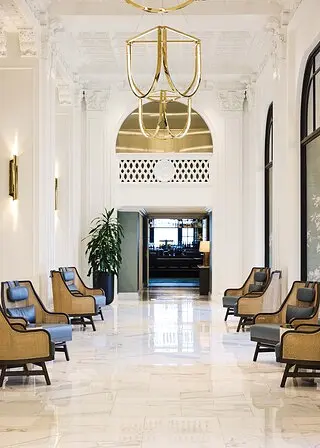
photo by: Joe Schmelzer
The restored original plasterwork in the lobby makes up a key part of the rehabilitation.
Long Beach in the 1920s was a beach town, easy to reach from L.A. How the hotel would have fared had the booming U.S. economy of the decade roared on is unknown, but it was open only three years before the stock market crash of 1929 brought the age of flappers and bathtub gin to an end. Hard economic times were followed by the Long Beach earthquake of 1933, a magnitude 6.4 event in the early evening of March 10 that leveled dozens of buildings, including 70 schools, and killed 120. Authorities felt the death toll would have been much higher if the quake had occurred earlier in the day, when schools were in session. Still standing amid the devastation, the Breakers served as the headquarters for the Red Cross relief efforts in Long Beach. But the disaster, on the heels of the Great Depression, brought the hotel to ruin as the tourist trade dried up. The Breakers declared bankruptcy in 1933.
Its next chapter would bring a touch of Hollywood glamour and the advent of the Sky Room, a restaurant at the top of the hotel that would become a treasured destination for Long Beach residents and guests.
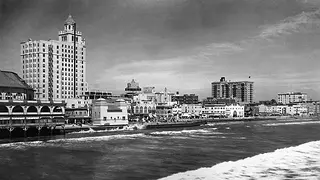
photo by: Archives of the Historical Society of Long Beach
The hotel in 1926.
Every renovation that meets modern needs is both a rebirth and a reimagining. In the case of the Breakers, the years of different uses and ownership meant that much of its interior detailing had been lost or well hidden. Recapturing the hotel’s past grandeur meant first working with what was there. “What had happened [was], different owners were less concerned about its historic importance,” says Esteghamat.
In addition to the changes made to match the hotel’s shifting identity, the building also had been significantly altered over time to deal with a recurring fact of life in California: earthquakes. The hotel had survived the 1933 temblor, but over the years, its owners had added concrete shear walls to help it survive future quakes. Further concrete infills took out two banks of windows all the way up the building for 13 stories, which blocked the view from the main-level bar to Ocean Boulevard. The rehabilitation team reopened the large windows in the bar. “Now you have all that natural light, and you can see out to Ocean Boulevard again,” says Pacific6’s Ben Grubb, who managed the project’s construction.
Removing structural concrete elements required finding other ways to reinforce the space. “We had to go downstairs and beef up the structure because upstairs we were taking structure away,” says Grubb. His team came up with innovative ways to retrofit the nearly 100-year-old building, such as using fiber-reinforced polymer wrap, which Grubb jokingly describes as “super-strength duct tape.” The wrap bolsters the structural integrity of the floors and walls while also giving the building greater capability to flex during a quake.
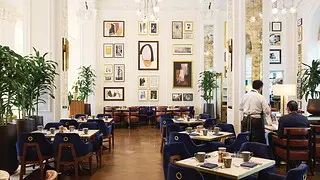
photo by: Joe Schmelzer
Nettuno, an Italian restaurant, contains historic plaster detailing.
The configuration of key spaces had been significantly altered over the years. The elevator lobby’s space had been visually cut in half, its ceiling lowered to accommodate an additional stairwell. Crews moved the stairwell forward and brought the ceiling back to its original height, which allowed “the space to look like it was originally intended,” says Esteghamat.
Guest-room floors had to be completely cleared out and redone, but “we worked with existing fenestration and [some] existing walls and columns to create the new [larger] room layouts,” Esteghamat notes. Marble thresholds for the rooms and bathrooms, as the hotel had in the past, were installed to recapture the lost sense of refinement.
The team uncovered and restored small treasures throughout the project. Esteghamat is particularly proud of beautiful plaster medallions of sailing ships, which had been hidden behind the reception area during past remodeling, that were reclaimed and moved to a place of prominence in the new first-floor restaurant, Nettuno. The pièce de résistance of the renovation, however, came high atop the hotel in the completely revamped Sky Room.
“It’s safe to say that everybody in Long Beach has a Sky Room story.”
John Molina
Conrad Hilton purchased the Breakers in 1938, making it the eighth hotel in his chain. Hilton spent $200,000 on renovations—about $4.5 million in today’s dollars—and it quickly grew into a favorite Hollywood retreat. “Long Beach back in those days was [about] an hour’s drive from Hollywood,” says John Thomas, a preservation consultant for the rehabilitation. “But it wasn’t Hollywood, so you could come here, people would still know you, but you weren’t bothered by them.”
The stars frequented the beach outside the hotel, Thomas adds, giving them a sun-and-sand retreat where they could unwind. Clark Gable, Errol Flynn, Rita Hayworth, and Cary Grant were among the stars of Hollywood’s Golden Age who visited the hotel in the late 1930s and ’40s. John Wayne may have been fond of the downstairs bar, but it was the elegance of the Sky Room, along with the nearly 360-degree nighttime views of sea and city, that made it a magnet for celebrities.

photo by: Joe Schmelzer
The redesigned Sky Room restaurant on the top floor pays tribute to an earlier Art Deco incarnation.
The days of glamour were interrupted during World War II, when the room was used on and off as an Air Watch headquarters for Long Beach. Two pillboxes (one of which remains today) with gun mounts were installed on the rooftop. The Sky Room continued as an event destination long after the war—not just for celebrities, but also for Long Beach residents. “It’s safe to say that everybody in Long Beach has a Sky Room story,” says Molina. “When my wife and I were [expecting] our first child, we took my mother, my wife’s parents, and her grandmother there and surprised them with the announcement.”
The Breakers had been sold by the Hilton chain and renamed the Wilton Hotel by the time Conrad “Nicky” Hilton Jr. and his 18-year-old bride Elizabeth Taylor spent their wedding night there in 1950. The hotel changed ownership again before it became primarily a luxury retirement home in the mid-1960s. There was an attempt to return the building to its original purpose as a hotel in the 1980s, but that failed in 1988, and the hotel and Sky Room closed.
A year later, the building was designated a Long Beach Historic Landmark, requiring approval from the city’s Cultural Heritage Commission before any major changes could be made to its exterior. In 1990 it reopened as an assisted-living facility, a far cry from its glory days. But a reminder of those days remained in the Sky Room, which reopened as a restaurant in the late ’90s. Esteghamat remembers that you had to use a separate entrance on a side street, where a doorman escorted you to a dedicated elevator that took you up to the restaurant. Over time the Sky Room fell into disrepair, but the loyalty of Long Beachers ensured it remained open even after the assisted-living facility closed, shutting down only for renovations once the building was acquired by Pacific6 a couple years later.
The beach no longer abuts Fairmont Breakers. In 1931, the Rainbow Pier, an unusual horseshoe-shaped pier that circled out into the ocean and back, opened in Long Beach. The area within the pier’s arc was known as Rainbow Lagoon, and the hotel’s beach was originally in the lagoon. “In the ’60s, Long Beach started a massive redevelopment project turning what had been beach into land for the convention center and other buildings—no more beachfront property for the hotel,” says Chris Hogan, president of Long Beach Heritage.
The change was only one of many for Long Beach since the hotel was built. The city has been a beach town, an oil town, a Navy town, a factory town, and a port town over the decades.
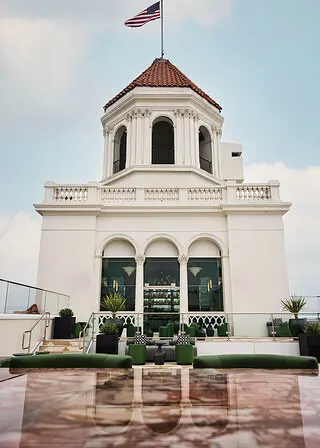
photo by: Joe Schmelzer
A preserved pillbox (at right) from World War II pops out from the tower above Halo, the hotel’s rooftop cocktail lounge.
All those incarnations still exist in some form in today’s city, but recently, Long Beach civic leaders have been emphasizing hospitality and entertainment—a return, really, to the city’s identity when the Breakers first opened.
Since 1967, the Queen Mary, the British ocean liner that was the queen of the seas when launched in the 1930s, has been docked in Long Beach, serving as a floating hotel and a popular tourist attraction.
The city also has the Aquarium of the Pacific, which attracts about 1.6 million visitors a year. Finally, when the Olympics come to Los Angeles in 2028, Long Beach will host several events, including beach volleyball and marathon swimming. The reopened Fairmont Breakers seems well positioned to take up its original role. “It sits right next to the convention center,” says Molina.
A highlight of any visit will be dinner at the Sky Room. Although the windows are the only historical details that remain in this space, its new serpentine lighting, geometric-patterned marble floor tiles, and curved banquettes all evoke the Art Deco era. It’s the pinnacle achievement in a rehabilitation that preserved what it could of the hotel’s original interior and incorporated changes that honor its past. Esteghamat hopes the renovation will return the building to its central role in the community.
“It’s become a hub,” he says. “It’s brought people together: ‘Let’s meet at the Breakers.’”
Donate Today to Help Save the Places Where Our History Happened.
Donate to the National Trust for Historic Preservation today and you'll help preserve places that tell our stories, reflect our culture, and shape our shared American experience.


